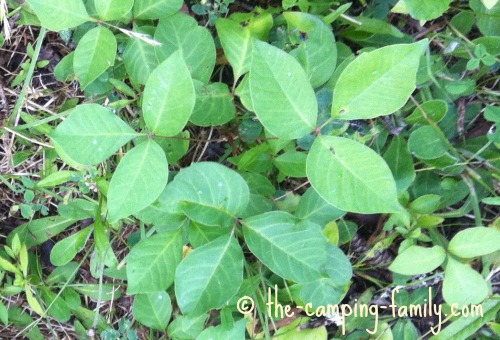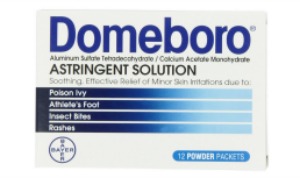Search this site.
The Poison Ivy Plant:
How to Identify and Avoid It
Stay away from the poison ivy plant when you are camping and hiking!

Poison ivy contains urushiol oil, which can cause a very unpleasant reaction in many human beings.
How to identify poison ivy
Recognizing poison ivy is not an easy task, because there are so many varieties.
- Some poison ivy plants look like bushes.
- Others grow vines.
- Some grow low to the ground.
- Others grow as high as three feet tall.
The leaves can be green or red, shiny or dull, smooth-edged or jagged.
The leaves are in groups of three - but so are the leaves of many other plants!
Your best bet: take a close look at the leaves.
Each leaf of a poison ivy plant is made of three leaflets.
The stalk of the side leaflets are shorter than the stalk of the middle leaflet.
When in doubt, remember the old rhymes:
"Leaves of three, let it be!"
"Berries white, shun the sight!"
Avoid any plant with white berries or groups of three leaves, just in case!
How to avoid poison ivy
- Learn about the types of poison ivy that grow in your area, so you'll know what to look for.
- Check around your campsite for poison ivy. Point it out to your family, and make sure they know to stay away.
- On a hike, make it a habit to be on the lookout for poison ivy at all times.
- When hiking in areas where the plants might be present, wear long pants, long sleeves and gloves.
- If you do hike in an area where poison ivy is present, remove your clothes carefully when you get back to camp. Don't touch them again until they have been washed.
- Keep in mind that urushiol oil can be spread. If it's on your dog, or your boots, or your child, and you touch it, you can get develop a rash.
- You might want to try a poison ivy barrier cream. These are rubbed on the skin like sunscreen and are said to protect you for hours - even if you touch poison ivy. I haven't used these and can't recommend them. (Have you used them? Do they work? Please let me know!)
If you do have the misfortune to touch poison ivy and contract a rash, here's what you need to know about treating poison ivy.
 |
I hope that you don't ever get a poison ivy rash - but if you do, give this product a try. Many reviewers have found that it relieves the itching and promotes healing. |
Poison ivy removal
You'll probably be able to avoid the poison ivy plant at camp - but what if you have it at home in your yard? You'll want to get rid of it - either by killing it with herbicide, or by digging it up.
How to kill poison ivy
Poison ivy can be killed by certain chemical weed-killers. Check with your garden center for the most appropriate choice for your area. Be sure to read the label and to follow the manufacturer's directions and safety precautions.
However, there is no product that kills only poison ivy. A herbicide that kills poison ivy may also kill or damage the other plants nearby. If you have poison ivy in your yard or garden, your only alternative may be to physically remove it.
How to dig up poison ivy
I'm sorry to tell you that removing poison ivy by hand is not an easy task. You will need to dig out every stem and every root.
Getting every piece of underground stem is almost impossible, and chances are high that the plant will regrow.
Take safety precautions.
The toxic oil can be sprayed out from the plants as you cut and pull them.
If you know that you react badly to urushiol, don't attempt this at all.
If you do decide to dig up poison ivy plants, be sure to follow these safety measures.
- Wear long pants, long sleeves, and gloves.
- Cover your face with a mask or bandanna.
- Be aware that your clothes, footwear and tools will become contaminated with the oil. Don't touch them with your bare hands until you have cleaned them.
Dispose of the plants safely.
Disposing of poison ivy plants is another problem.
Some sources recommend burning the plants, but the oil can be dispersed by the smoke, threatening everyone in the area.
Sealing the plants in plastic bags and taking them to the dump is probably the best idea.
Frequently asked questions about the poison ivy plant
Can dogs get poison ivy?
No.
Dogs are not affected by poison ivy themselves, but if they get the oil on their fur and you pet them, you might get the rash.
Is poison ivy contagious?
No. If your friend has a poison ivy rash and you touch it, you will not contract a rash yourself.
Even if you touch the fluid that comes out of a burst poison ivy blister, you won't get a rash. Poison ivy blisters contain fluid, but the fluid does not contain urushiol.
However, if your friend still has urushiol oil on herself and you touch that, you can get a rash.
Poison ivy facts
Poison ivy's relatives can be toxic too!
If you have had a reaction to poison ivy in the past, you might now react to plants that are related to poison ivy - or to products made from those plants. Here's a partial list:
- the rind of mangoes
- the sap of the lacquer tree - and anything treated with the sap - like Japanese lacquerware
- the fruit of the Ginkgo tree
- the shells of cashew nuts
Urushiol is toxic in very tiny amounts.
For example, a drop of urushiol the size of the head of a pin would be enough to cause itching in 500 people!
Urushiol stays toxic for a very long time.
I read that centuries-old urushiol can cause itching in people with sensitive skin!
Most popular
|

